I haven’t talked too much yet about why the Traditional City works, and other designs do not. I figured you would just get the message from the photos — it’s pretty obvious isn’t it? However, since we are aiming here not only to be a diner who can say “mmmm — yummy!” but actually a chef who knows exactly how to make that effect, let’s talk more about how the Traditional City works.
“There’s no there there,” said Gertrude Stein famously about Oakland, California. She was speaking on a vague, aesthetic level, but it is also true on a physical, square-feet kind of level too. I say that there are two kinds of sqare-footage in a city: Places and Non-Places.
Places are areas where things happen. This includes:
Houses
Offices
Factories
Warehouses
Beaches
Marinas
Parks
Museums
Restaurants
Shops
Theaters
Schools
Hotels
Sports fields
Train stations
Plazas/central squares
Gardens/yards/courtyards
In short, if you “do something,” like work or sleep or go shopping or have a picnic or a party, it’s the place where you do it. A destination. The location where people interact. Places are universally pedestrian places. Nothing happens while people are in their cars. Cars are just the means to get from one Place to another Place.
Non-Places are areas of the city where nothing happens. This includes:
Parking lots
Useless greenery (not a park, but landscaping where nobody goes)
Roadways and other transportation infrastructure
Areas around buildings which are not “destinations,” and often have no real purpose
I think you understand exactly what I’m talking about. Notice that almost every area is easily categorized as one or the other. There aren’t many exceptions.
When more and more of a city consists of Places, then there’s “more there there,” as Gertrude Stein might say. When most of a city consists of Non-Places, then there’s “less there there,” until finally there is “no there there.”
That’s it! It’s as simple as that.
So, obviously, we want to maximize our Places and minimize our Non-Places, if we want to have a successful outcome.
If we look at the Traditional City, we see that it is mostly Places. To the degree that we can eliminate cars, the Traditional City can become almost 100% places.
A pedestrian street is a Place. When it becomes dominated by cars — to the point where a person is not comfortable walking down the middle of the street — it becomes a Non-Place. This doesn’t mean that you have to ban automobiles completely. You can have automobile access, which will be necessary for deliveries and the occasional taxi, but the street can still be dominated by pedestrian activity. I mentioned that 90% of the streets in Tokyo have no cars on them. This is not because it is forbidden, but because it’s damn difficult to drive a car on a Really Narrow Street, and nobody really needs to anyway.
Some people may disagree with my characterization of roadways, but a car-dominated roadway (as opposed to a pedestrian Really Narrow Street) is really transportation infrastructure no different than a rail line. It is noisy and stinky and dangerous and completely hostile to humans (“pedestrians”), just like a rail line. I think it is best to put the transportation infrastructure — in my examples a subway system — entirely underground, which allows the Traditional City to attain its traditional ratio of 100% Places.
If you look at all the streets that are destinations, like Rodeo Drive or the Champs Elysees, or Madison Avenue and so forth, the places where people say: “let’s go to XXX”, they are all pedestrian places. Probably with shopping involved. There might be cars too — a lot of them — but nobody is saying “let’s go stand in the middle of traffic on Madison Avenue,” they are talking about the pedestrian places. If you could get rid of the automobile roadways — for example, connect the two sidewalks of Madison Avenue to make a pedestrian street about 25 feet wide from building to building — it would be just as much of a destination, maybe more so.
One of the biggest and most destructive Non-Places in cities today is Green Space. Note that it is always termed “green space.” It is not a park, or a backyard, or a sports field, or even a wholly natural area like a forest. If people were talking about parks, they would say: “we have plenty of parks.” But they don’t say that, they say: “we have plenty of Green Space.” Green Space is not a place where things happen. Do you ever say: “Let’s get the kids together and have a picnic in that grassy area between the northbound and southbound I-95.” No, that never happens. How about: “Let’s go play soccer in that grassy area by the Wal-Mart parking lot.” These are things that happen in parks and sports fields, which are traditional components of the Traditional City, not Green Space.
Green space is a new invention. What’s it for? Green Space was invented to make our other Non-Places less horrible. It basically doesn’t exist in the Traditional City.
One of the basic problems with Non-Place is that it’s contagious. When you start introducing Non-Places into a city design, you tend to add more and more Non-Places to try to fix the problems caused by the original Non-Places. If you have two Places next to each other, like an apartment building and a store, then you can easily walk from the apartment building to the store. If you put a big roadway in between, now you can no longer walk. You need a car. Now the apartment building needs a parking lot. Now the store needs a parking lot. Now the roadway needs to get bigger because of all the people driving from the apartment to the store. Now you need to surround the apartment building with grass (or better yet, a row of trees) to add a little buffer between the apartment building and the noisy roadway, because who wants to live next to a roaring highway? Then, you need to surround all the parking spaces with more grass and shrubbery, so that you aren’t left with acres of burning asphalt. Then, the apartment building and the store are now so far from each other that you decide you need a freeway system. Then, because you have to drive the on/off ramps at 50 miles per hour, they need to have an enormous radius, and then they need to be surrounded by more green space and probably a cinder block wall so that people can tolerate the endless noise of a major freeway. Then, your city fills up with gasoline stations, car dealers, mechanics, auto parts stores, and all the paraphernalia needed to maintain all this transportation infrastructure. It is quite possible that your portion of Place to Non-Place in the city will fall below 10%. Essentially, the only Places left will be building interiors and a few parks (minus their parking lots).
One of the things you’ll notice about the Traditional City is that there is often not a lot of greenery in them. This might be considered a genuine problem. I would be all for greenery in the Traditional City, in the form of parks (concentrated greenery) and also just bits of flowers and trees here and there. However, the Traditional City can still be just fine — in fact quite wonderful — without this greenery. How much greenery is in Siena, Italy?

(There is essentially no Non-Place at all in this photo.)
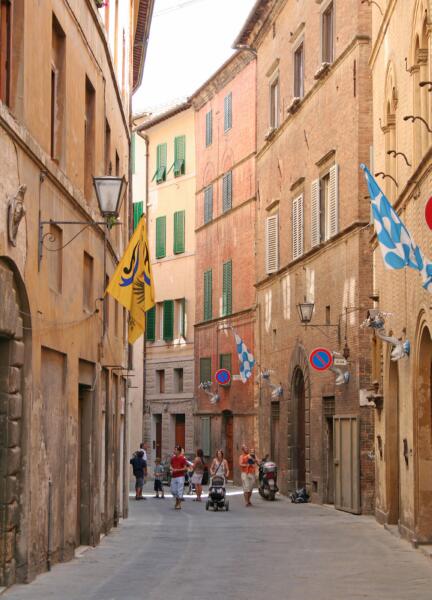
Not only are there hardly any parks to speak of, but on street level, you would have to get out a magnifying glass to find even the slightest trace of vegetation.
I don’t think Siena is the best possible Traditional City. But, along with Florence, it is a place that people have been traveling to for about 200 years because of its reputation as an urban concrescence of beauty and culture. Obviously, it appeals to people. Out of all the millions of tourists over the years, how many have collapsed in a heap, writhing in agony because of the shortage of Green Space? Exactly none. The Traditional City doesn’t need Green Space. Apparently, not even a single blade of grass — although a few parks here and there should probably be considered an improvement.
The Traditional City doesn’t need Green Space because it doesn’t suck to begin with. There is no problem we are trying to solve through the introduction of acres of mowed lawns.
The Traditional City doesn’t have to be devoid of vegetation. With the addition of only a rather small amount of trees and plants, it can become quite lush and verdant.
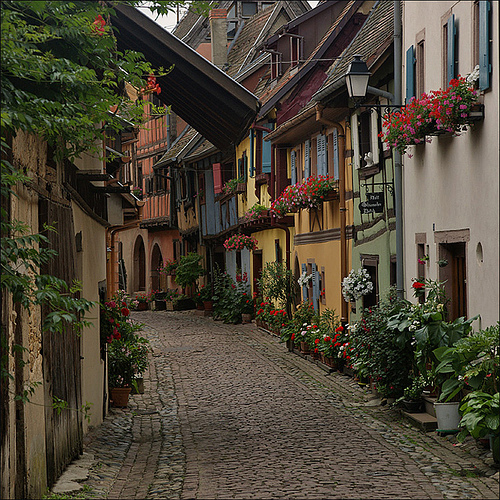
SONY DSC
This looks like a profusion of verdure, but actually there are just a few window boxes and potted plants. It’s almost nothing at all. The reason it seems so lush is that we don’t have to compensate for some kind of off-screen horror, like six lanes of roaring traffic. Note that there is not a single square inch of Non-Space in this photo.
At this point, there are always the literalists who want to know the exact species of red and pink flower used in the window boxes, as if that was the secret. It’s totally irrelevant! Grow marijuana in your window boxes if you want. The important thing is the Really Narrow Street, and its natural consequence, the elimination of auto traffic. Then, you want the buildings side-by-side, which eliminates the potential Non-Space between buildings. When you get that right, then you can add a little bit of whatever plant you like, and get a wonderful result.
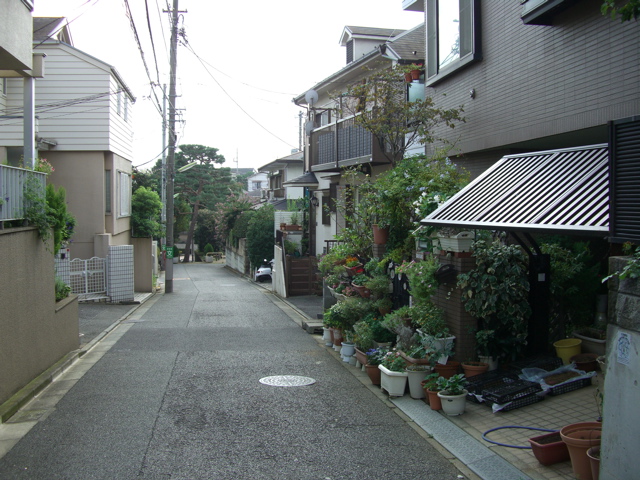
Here we have a completely different situation. This is eight thousand miles east, with buildings that date from the 1980s or so. This is not an antiquarian relic in the country, it is one of the most desirable neighborhoods of one of the wealthiest cities on the planet. Nevertheless, the result is just fine. You noticed that the street width is almost identical, right? It’s about eight feet. This is central Tokyo, namely the Yoyogi area just west of Meiji Jingu shrine — NOT a suburb. You can walk from here to either Shibuya or Shinjuku, both major downtown commercial districts. Many, many Tokyo urban residential areas look like this. These are single-family detached residences, also known as townhouses. Many have small backyards and gardens. Apartments are not strictly necessary, and in fact the first multifamily apartment building in Tokyo wasn’t built until the 1920s. (It was on Omote-Sando boulevard and was recently torn down. Yes — that one.) Once again, not a single square inch of Non-Space here. Add a subway station (in this case, the Yoyogi-Uehara station on the Chiyoda subway line), and you are done.
That’s it! That’s all there is to it.
It’s soooooo easy.
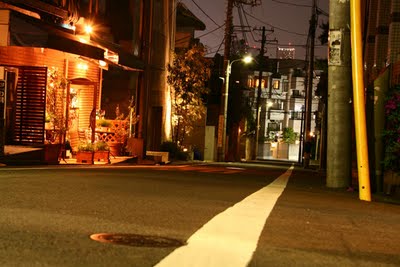
The walk down to Yoyogi-Uehara station.

Some local people obviously happy that they don’t live in Suburban Hell.
“Now THIS is an electric vehicle!”
It is difficult to explain, to someone who has never experienced it, that the Traditional City is actually a very quiet, lovely sort of place — even the largest Traditional Cities, with the Tokyo population well over 30 million. Many of our common assumptions about urban environments don’t apply. It doesn’t stink because there are no cars. (Fortunately, we are beyond the coal-burning age, and have good sanitation today.) It isn’t “noisy,” because it’s the cars making the noise, not people walking around. It isn’t “crowded,” even if there are lots of people, because what people usually mean by “crowded” is that there is lots of automobile traffic. The only way to solve these problems is to dump the cars. Most of what people don’t like about cities today is actually caused by automobiles. The residential university campus is about the closest experience most Americans have to a no-car urban place. There were lots of people at the university, but was it “crowded”? Never happens. How about the indoor mall — which is an approximation of a Traditional City shopping area. In fact, most people are attracted to those places that have lots of other people. It’s where the party is.
Practically everyone these days talks about Green Space as a necessary element of their ideal city. You even see people boasting about it, as in “45% of our Sustainable City of the Future consists of Green Space.” They are hinting: “You have a big vegetation buffer between you and the rest of Suburban Hell.” Which is, actually, desirable if you are living in Suburban Hell.
I consider Green Space to be absolute poison.
The rule of “Non-Places are contagious” also applies to Green Space. If you start adding Green Space everywhere, pretty soon you are going to need cars to get here and there. Then come the roadways and parking lots. Then comes more Green Space to make the roadways and parking lots a little less horrible.
I don’t think many people realize how much this poisonous Green Space concept has infected our ideas of how to build cities. For example:
Clackamas County, Oregon.
Title 12: Zoning and Development Ordinance.
Section 1000: Development Standards.1009 Landscaping, 1009.02 Minimum Area Standard
The minimum area requirements may include landscaping around buildings and in parking and loading areas, outdoor recreational
use areas, and buffering as required under this section (1009).A. Medium and High Density Residential: A minimum of twentyfive (25) percent of the gross land areas shall be used for landscaping in medium and high density districts. This requirement may be reduced to a minimum of twenty (20) percent when the development qualifies for bonus density under subsection 1012.040 for Site Planning and Design Excellence. Redevelopment or additions to multifamily developments shall meet the minimum area requirements of this section.
So, right off the bat, a minimum of 25% of our “medium and high density residential” area becomes a Non-Place — this before the parking and the roadways. Instant disaster. Instant automobile dependence.
The funny thing is, a whole legion of urban planning troglodytes think this Green Space is “sustainable,” that word which is magic fairy dust meaning almost nothing. If Non-Space leads to automobile dependence, and automobiles are not “sustainable” (arguably), then obviously, Green Space is the exact opposite of what you would want to do if you were really aiming at “sustainability” (whatever that means this week). Look at this paper to see what I mean:
Trees, Parking and Green Law: Strategies for Sustainability
You don’t really have to read much beyond the title. It perfectly describes how laughably fucked-up City Design is today, even among apparently well-meaning specialists. You might as well write a paper called: “Guns, Bombs and Imperial Ambition: Strategies for Peace.”
Here’s another one. It’s everywhere:
Creating Sustainable Communities: Delivering Greenspace in the Thames Gateway
Don’t you love that terminology? “Delivering Greenspace.” Like it was a commodity that flows down a pipe. How about “Build a Park?” And what is so goddamn “sustainable” about “greenspace”? Do you plan to graze goats or something?
I think a lot of these people actually plan to graze goats in the middle of the city. It is an idea buried in their mind. We should make them actually keep goats for a year. That should solve the problem.
You know what Ben Franklin would say:

“Fuck goats.”
April 19, 2009: Let’s Kick Around the “Sustainability” Types
Parks are fine, even very large parks like Central Park in New York — which is absolutely a Place, not a Non-Place. While the Traditional City can work well with almost no parks at all, I think you can devote up to 20% of the surface area to parks with an overall positive effect. The fact is, however, that people don’t really need parks that much in a Traditional City because the rest of the city is pleasant to begin with. There isn’t anything they need to “get away from.” In a pedestrian city, people do many of the things they might do in parks right in the street instead. I’ve already mentioned how I used to go jogging right down the middle of the street in central Tokyo, for miles on end (often through Yoyogi, actually), which was much more fun than doing laps in some park. Then I would take the train home. Kids will play ball and young men will ogle young women and old men will feed pigeons — in the middle of the street (or the no-car plaza). In practice, most people would rather spend their time at the cafe than the park, and you often find, in a Traditional City, that many people never go to the parks that are provided. They feel no need to.
Parks can be effective even when they are quite small. Even a 30×50 foot area can make a splendid park — sort of a shared backyard — within the context of a Traditional City.
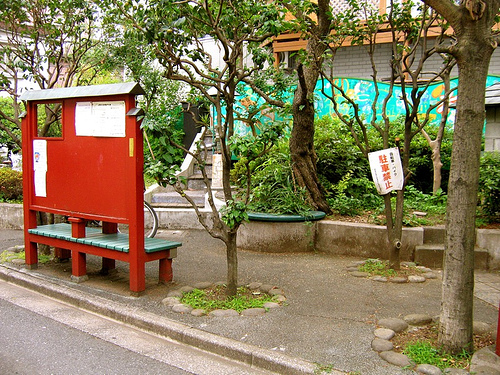
“Pocket park,” Ikebukuro, Tokyo
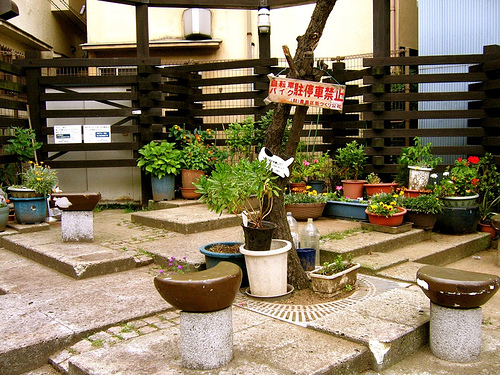
Another Ikebukuro “pocket park.” Of course you don’t have to make it this small. But you can if you want to!
One of the problems with Non-Space is that someone has to take care of it. All of that lawn and shrubbery and parking lot area needs to be maintained. Roads need to be plowed in winter. Usually this is not too difficult. But, just as nature abhors a vacuum, a Non-Place that is neglected soon fills up with something or other — trash, old automobiles and refrigerators, criminal activity, squatters, and so forth. One of the things about a Traditional City is that there is not really all that much space outside the buildings themselves. If Siena were in a snowy climate, for example, the roads could easily be cleared with hand shovels alone. In Japanese cities, many of which get lots of snow, it is traditional for each shopkeeper to shovel by hand the little bit of street in front of their store. If the street is sixteen feet wide (eight feet to the midpoint) and the storefront is thirty feet long, then they would have 8×30=240 square feet to shovel, which is nothing. (Actually it is traditional for shopkeepers to maintain the street in front of their store in all weather. Many will wash their little bit of pavement with a hose literally every single day.) Similiarly, a Traditional City is easier for a policeman to patrol because really the only open space is the Really Narrow Street, a little strip twelve feet wide, not acres and acres of asphalt and shrubbery.
The Traditional City can be maintained entirely with hand tools. You can build buildings and maintain streets and shovel snow all by hand — the way it has been done for hundreds and thousands of years. A lot of this suburban Non-Space can’t really be maintained without machines. Who is going to mow all that Green Space without a motorized lawnmower? (I can hear it already: “We’ll graze goats!”) Who could maintain all that pavement if they had to do it with cobblestones? Which says something about “sustainability” to those who are paying attention. Even a subway or train system can be built and maintained by hand, and in fact that is how it was originally done in the 19th century.
We described earlier the failed pattern of City Design that we called the Hypertrophic City. You can understand the failure of the Hypertrophic City by way of Place and Non-Place. The Hypertrophic City typically consists of very large buildings surrounded by very large roadways and plenty of Green Space. Although the buildings are very large, typically the land area occupied by the building itself is a relatively small amount of the overall space available — perhaps 10%-20%. Except for the occasional swimming pool, everything outside the buildings consists of Non-Place, in the form of Green Space, giant roadways, and (sometimes) parking lots. The only thing to do is to get in a car and go to another megabuilding somewhere. Does that sound like Dubai or Las Vegas?
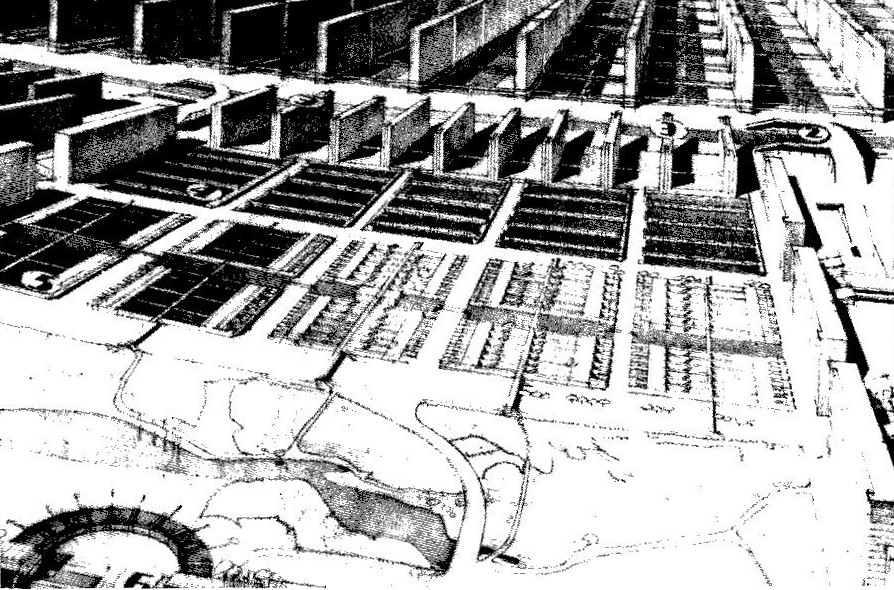
Richard Neutra’s Rush City Transformed, from 1928. Ninety percent Non-Space, combined with some sterile megabuildings. You don’t even have to build it to know that the result is going to be 90% suckitude, and the remaining 10% mega-sterile. It’s inevitable.
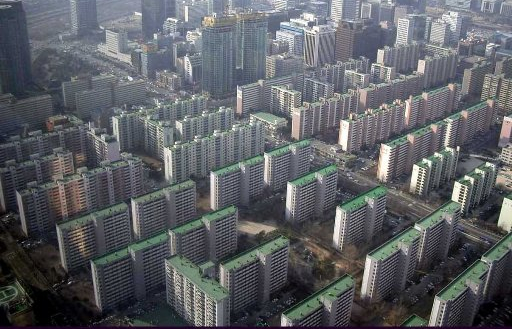
Part of Seoul, South Korea. Actually, Seoul is a vastly underappreciated city, with many Tokyo-like Traditional City-type neighborhoods that are lots of fun. This district, however, just goes to prove that all Hypertrophic Cities suck the same way. Despite the megabuildings, it is not even all that dense. If you built the whole thing Traditional City-style, four stories high with Really Narrow Streets like Florence, I bet you would end up with more total floor space.
We will talk more about the specifics of incorporating vegetation and naturalistic elements — parks, sports fields, gardens, courtyards etc. — into the Traditional City in the future.
Other comments in this series:
September 28, 2009: Let’s Take a Trip to Barcelona
September 20, 2009: The Problem of Scarcity 2: It’s All In Your Head
September 13, 2009: The Problem of Scarcity
July 26, 2009: Let’s Take a Trip to an American Village 3: How the Suburbs Came to Be
July 19, 2009: Let’s Take a Trip to an American Village 2: Downtown
July 12, 2009: Let’s Take a Trip to an American Village
May 3, 2009: A Bazillion Windmills
April 19, 2009: Let’s Kick Around the “Sustainability” Types
March 3, 2009: Let’s Visit Some More Villages
February 15, 2009: Let’s Take a Trip to the French Village
February 1, 2009: Let’s Take a Trip to the English Village
January 25, 2009: How to Buy Gold on the Comex (scroll down)
January 4, 2009: Currency Management for Little Countries (scroll down)
December 28, 2008: Currencies are Causes, not Effects (scroll down)
December 21, 2008: Life Without Cars
August 10, 2008: Visions of Future Cities
July 20, 2008: The Traditional City vs. the “Radiant City”
December 2, 2007: Let’s Take a Trip to Tokyo
October 7, 2007: Let’s Take a Trip to Venice
June 17, 2007: Recipe for Florence
July 9, 2007: No Growth Economics
March 26, 2006: The Eco-Metropolis
* * *
Collapsing Fisheries Watch:
Good article from the New Republic:
The jig, however, is nearly up. In 1950, the newly constituted Food and Agriculture Organization (FAO) of the United Nations estimated that, globally, we were catching about 20 million metric tons of fish (cod, mackerel, tuna, etc.) and invertebrates (lobster, squid, clams, etc.). That catch peaked at 90 million tons per year in the late 1980s, and it has been declining ever since. Much like Madoff’s infamous operation, which required a constant influx of new investments to generate “revenue” for past investors, the global fishing-industrial complex has required a constant influx of new stocks to continue operation. Instead of restricting its catches so that fish can reproduce and maintain their populations, the industry has simply fished until a stock is depleted and then moved on to new or deeper waters, and to smaller and stranger fish. And, just as a Ponzi scheme will collapse once the pool of potential investors has been drained, so too will the fishing industry collapse as the oceans are drained of life.
Unfortunately, it is not just the future of the fishing industry that is at stake, but also the continued health of the world’s largest ecosystem. While the climate crisis gathers front-page attention on a regular basis, people–even those who profess great environmental consciousness–continue to eat fish as if it were a sustainable practice. But eating a tuna roll at a sushi restaurant should be considered no more environmentally benign than driving a Hummer or harpooning a manatee. In the past 50 years, we have reduced the populations of large commercial fish, such as bluefin tuna, cod, and other favorites, by a staggering 90 percent. One study, published in the prestigious journal Science, forecast that, by 2048, all commercial fish stocks will have “collapsed,” meaning that they will be generating 10 percent or less of their peak catches. Whether or not that particular year, or even decade, is correct, one thing is clear: Fish are in dire peril, and, if they are, then so are we.
This article is good, but actually the situation is much, much worse than you think. I’ll recommend again:
The Unnatural History of the Sea, by Callum Roberts
* * *
Here’s an item of mine that ran in the Huffington Post:

